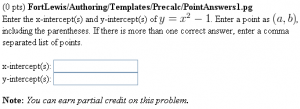Difference between revisions of "PointAnswers1"
Paultpearson (talk | contribs) (PGML example link) |
(Removes the AnswerFormatHelp macro and some other cleanup.) |
||
| Line 16: | Line 16: | ||
<tr valign="top"> |
<tr valign="top"> |
||
| − | <th> PG problem file </th> |
+ | <th style="width: 40%"> PG problem file </th> |
<th> Explanation </th> |
<th> Explanation </th> |
||
</tr> |
</tr> |
||
| Line 43: | Line 43: | ||
loadMacros( |
loadMacros( |
||
| − | + | 'PGstandard.pl', |
|
| − | + | 'MathObjects.pl', |
|
| − | + | 'contextLimitedPoint.pl', |
|
| − | + | 'PGML.pl', |
|
| + | 'PGcourse.pl' |
||
); |
); |
||
| Line 66: | Line 66: | ||
<td style="background-color:#ffffdd;border:black 1px dashed;"> |
<td style="background-color:#ffffdd;border:black 1px dashed;"> |
||
<pre> |
<pre> |
||
| − | Context( |
+ | Context('LimitedPoint'); |
| − | $f = Compute( |
+ | $f = Compute('x^2-1'); |
| − | $xint = List( Point( |
+ | $xint = List( Point('(1,0)'), Point('(-1,0)') ); |
| − | + | $yint = List( Point('(0,-1)') ); |
|
| − | $yint = List( Point("(0,-1)") ); |
||
</pre> |
</pre> |
||
</td> |
</td> |
||
| Line 94: | Line 94: | ||
<td style="background-color:#ffdddd;border:black 1px dashed;"> |
<td style="background-color:#ffdddd;border:black 1px dashed;"> |
||
<pre> |
<pre> |
||
| − | Context()->texStrings; |
||
| + | BEGIN_PGML |
||
| − | BEGIN_TEXT |
||
| + | Enter the [`x`]-intercept(s) and [`y`]-intercept(s) |
||
| − | Enter the x-intercept(s) and y-intercept(s) |
||
| + | of [` y = [$f] `]. Enter a point as [` (a,b) `], |
||
| − | of \( y = $f \). Enter a point as \( (a,b) \), |
||
| + | including the parentheses. If there is more |
||
| − | including the parentheses. If there is more |
||
| + | than one correct answer, enter a comma |
||
| − | than one correct answer, enter a comma |
||
separated list of points. |
separated list of points. |
||
| − | $BR |
||
| + | |||
| − | $BR |
||
| + | + [`x`]-intercept(s): [_________________]{$xint} |
||
| − | x-intercept(s): \{ ans_rule(20) \} |
||
| + | |||
| − | \{ AnswerFormatHelp("points") \} |
||
| + | + [`y`]-intercept(s): [_________________]{$yint} |
||
| − | $BR |
||
| + | |||
| − | y-intercept(s): \{ ans_rule(20) \} |
||
| + | [@ helpLink('points') @]* |
||
| − | \{ AnswerFormatHelp("points") \} |
||
| + | END_PGML |
||
| − | END_TEXT |
||
| − | Context()->normalStrings; |
||
</pre> |
</pre> |
||
<td style="background-color:#ffcccc;padding:7px;"> |
<td style="background-color:#ffcccc;padding:7px;"> |
||
| Line 115: | Line 112: | ||
<b>Main Text:</b> |
<b>Main Text:</b> |
||
Be sure to tell students the proper syntax for how to enter their answers. |
Be sure to tell students the proper syntax for how to enter their answers. |
||
| − | </p> |
||
| − | </td> |
||
| − | </tr> |
||
| − | |||
| − | <!-- Answer evaluation section --> |
||
| − | |||
| − | <tr valign="top"> |
||
| − | <td style="background-color:#eeddff;border:black 1px dashed;"> |
||
| − | <pre> |
||
| − | $showPartialCorrectAnswers = 1; |
||
| − | |||
| − | ANS( $xint->cmp() ); |
||
| − | |||
| − | ANS( $yint->cmp() ); |
||
| − | </pre> |
||
| − | <td style="background-color:#eeccff;padding:7px;"> |
||
| − | <p> |
||
| − | <b>Answer Evaluation:</b> |
||
</p> |
</p> |
||
</td> |
</td> |
||
| Line 142: | Line 121: | ||
<td style="background-color:#ddddff;border:black 1px dashed;"> |
<td style="background-color:#ddddff;border:black 1px dashed;"> |
||
<pre> |
<pre> |
||
| − | Context()->texStrings; |
||
| + | BEGIN_PGML_SOLUTION |
||
| − | BEGIN_SOLUTION |
||
| − | ${PAR}SOLUTION:${PAR} |
||
Solution explanation goes here. |
Solution explanation goes here. |
||
| − | END_SOLUTION |
||
| + | END_PGML_SOLUTION |
||
| − | Context()->normalStrings; |
||
| − | |||
| − | COMMENT('MathObject version.'); |
||
| − | |||
ENDDOCUMENT(); |
ENDDOCUMENT(); |
||
</pre> |
</pre> |
||
Revision as of 13:04, 10 March 2023
Answer is a Point or a List of Points
This PG code shows how to evaluate answers that are points or lists of points.
- File location in OPL: FortLewis/Authoring/Templates/Precalc/PointAnswers1.pg
- PGML location in OPL: FortLewis/Authoring/Templates/Precalc/PointAnswers1_PGML.pg
| PG problem file | Explanation |
|---|---|
|
Problem tagging: |
|
DOCUMENT(); loadMacros( 'PGstandard.pl', 'MathObjects.pl', 'contextLimitedPoint.pl', 'PGML.pl', 'PGcourse.pl' ); TEXT(beginproblem()); |
Initialization:
We only need to load |
Context('LimitedPoint');
$f = Compute('x^2-1');
$xint = List( Point('(1,0)'), Point('(-1,0)') );
$yint = List( Point('(0,-1)') );
|
Setup:
We could have used |
BEGIN_PGML
Enter the [`x`]-intercept(s) and [`y`]-intercept(s)
of [` y = [$f] `]. Enter a point as [` (a,b) `],
including the parentheses. If there is more
than one correct answer, enter a comma
separated list of points.
+ [`x`]-intercept(s): [_________________]{$xint}
+ [`y`]-intercept(s): [_________________]{$yint}
[@ helpLink('points') @]*
END_PGML
|
Main Text: Be sure to tell students the proper syntax for how to enter their answers. |
BEGIN_PGML_SOLUTION Solution explanation goes here. END_PGML_SOLUTION ENDDOCUMENT(); |
Solution: |
